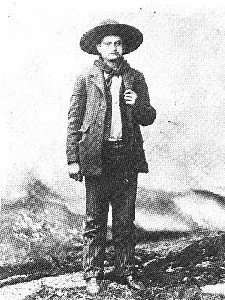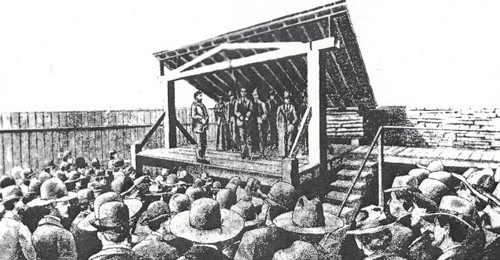|
|
1876 was a remarkable
year for America. Alexander Graham Bell made the first phone call
in Boston, Massachusetts; Custer had his last stand at Little Bighorn,
Montana Territory; and Crawford Goldsby was born at Fort
Concho, Texas. Now this last event may not sound like such a
big deal, until you know that, by the age of 20, Crawford Goldsby,
later known as Cherokee Bill, was one of the most notorious killers
prowling the western frontier. He was known to kill anyone he didn't
like, kith and kin being no exception.
Crawford's mother was Cherokee, African, and white, and his father
was a slave who had been freed for his contributions to the Civil
War. At the age of seven, Crawford saw his father slaughtered by
the Ku Klux Klan, so it's likely that his bad temper and lust for
revenge against his fellow man can be traced back to this tragedy.
His brokenhearted mother left Texas and headed for Fort Gibson,
Oklahoma, with little Crawford, his sister and two brothers. When
the time was right, she sent him to the Indian School in Kansas
for three years, followed by an industrial school for Indians in
Carlisle, Pennsylvania.
At the age of 12, Crawford returned to Fort Gibson and discovered
his mother had married a man he couldn't get along with. Crawford
rebelled by hanging out with a bad crowd and drinking lots of bad
liquor. At the age of 15, Crawford moved in with his sister and
her husband, Mose Brown, in Nowata, Oklahoma, but couldn't get along
with Brown either. He returned to Fort Gibson, bunking with a buddy
and working as a handyman. So far, so good. Nobody had yet worked
young Crawford into the lather of rage that later would cost so
many their lives. He didn't begin to get that reputation until he
was 18. It happened at a dance.
Soon after
arriving at the dance with one of his brothers, a man named Jake
Lewis began to pick on Crawford's sibling, whereupon Crawford grabbed
a six-shooter and blasted away at the bully. Since there was a guy
lying there on the floor, apparently dead as a doornail, and there
were no names on his dance card anyway, Crawford did what he had
to do. He fled.
Crawford met up with the outlaw Cook brothers, Jim and Bill, who,
like him, were part Cherokee. A match made in heaven? More like
the other, hot place. In 1894, the U.S. government bought a strip
of Cherokee land, offering $265.70 to each person with a legal claim.
Smelling easy money but wary of the lawmen who were after Crawford
Goldsby for the Lewis shooting and Jim Cook on larceny charges,
they couldn't very well just saunter into a government office and
ask for their money.
Instead of taking a chance on getting caught, they persuaded a restaurant
proprietress, Effie Crittenden, to go to Tahlequa and collect the
money for them. However, an enterprising sheriff, Ellis Rattling
Gourd, followed her back with a posse, in hopes of apprehending
the wanted men. Not the best idea Sheriff Gourd ever had.
A gunfight ensued with Crawford and the Cook brothers on one side,
and Gourd and his posse on the other, not what could be called an
even match, except for the marksmanship of Crawford. One of the
Sheriff's men, Sequoyah Houston, met his maker that day, and Jim
Cook was wounded. What was left of the posse rode off in a hail
of bullets.
When Effie Crittenden was later question by authorities and asked
if Crawford had been involved in the gunfight, she loyally (or fearfully)
replied, "No, it was not Crawford Goldsby. It was Cherokee Bill."
Thus she dubbed him with the name he would carry from then on. He
was now one of he most dangerous men in Indian territory. Crawford
Goldsby and the Cook brothers were henceforth elevated by his reputation
to the more intriguing title of The Cook Gang.
|
 |
Cherokee Bill
Photo courtesy of legendsofamerica.com |
|
The
Gang robbed banks, held up stagecoaches, and stole from shopkeepers.
Anyone who got in their way was quickly launched into eternity by
one, two, or all three members of the Gang. At one point during
this reign of terror, Cherokee Bill got into an argument over some
hogs with his brother-in-law, Mose Brown. He went hog wild, shot
and killed poor Mose without a second thought, and never looked
back. Now the authorities were really mad and decided to catch Cherokee
Bill at all costs. The Cook brothers thought better of their association
with the seriously sought Cherokee Bill and the Gang split up. At
this point, lawmen offered $1,300 reward for the capture of Cherokee
Bill, dead or alive. Since he wasn't too good at making friends,
Cherokee Bill's acquaintances responded to the reward and lined
up with hot tips.
Cherokee Bill managed to evade the law until April 1895 when he
was captured, convicted, and sentenced to death in Ft. Smith, Arkansas.
Apparently, Cherokee Bill could turn on the charm if the stakes
were big enough. He befriended a jailhouse guard, Sherman Vann,
and got him to smuggle in a six-shooter. Cherokee Bill jumped the
night guards, shot guard Lawrence Keating in the stomach and again
in the back as Keating staggered down the corridor. New guards arrived
in such numbers as to thwart Cherokee Bill's plan to escape. All
he could do was prevent them from entering his cell, presumably
by waving his weapon around. With his reputation and what he had
just done to their colleague, the guards were rightly scared.
A courageous prisoner, Henry Starr, did some fancy talking and the
guards permitted him to enter Cherokee Bill's cell where he was
able to negotiate a surrender. That was the beginning of the end
for Crawford Goldsby.
|
 |
Cherokee Bill
on the gallows
Photo courtesy of nps.gov |
|
Convicted and
sentenced to death yet again, this time for the killing of guard
Keating, Crawford was ready to shake hands with the grim reaper
on March 17, 1876. When brought up to the gallows, he blithely commented,
"This is as good a day to die as any." Standing on the platform,
noose about his neck, he was asked by the hangman if he had any
last words. He replied, "No!! I came here to die, not make a speech."
In the end, the death toll of men killed due to Crawford's violent
temper, rose by one: Crawford Goldsby himself.
© Maggie
Van Ostrand
"A Balloon In Cactus"
March
27, 2008 column
|
|
|
